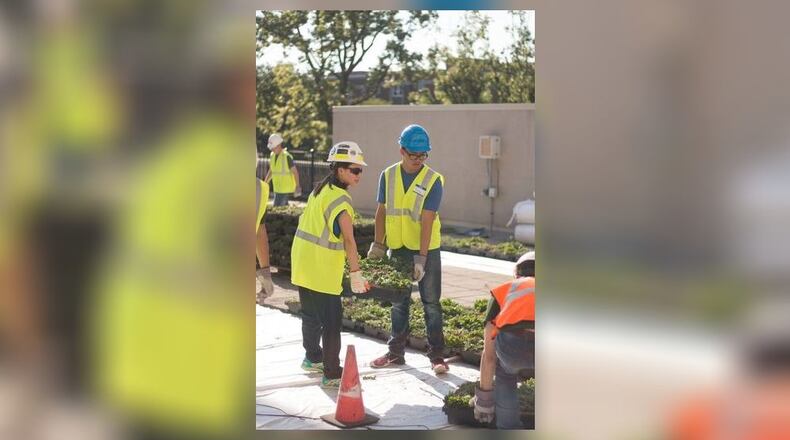It’s all part of the ongoing sustainability initiatives funded by George and Amanda Hanley of Chicago. George is a 1977 UD business graduate. The George and Amanda Hanley Foundation gave the university $12.5 million in 2014, the largest single gift in UD’s history, university officials say.
That gift established the Hanley Sustainability Institute to support the university’s sustainability education programs. The Kennedy Union rooftop garden project started in August with political science, geology, engineering and computer science students installing temperature sensors. The students will compare before-and-after readings to see how temperature changes affect energy costs.
“Our charge with the gift from George and Amanda Hanley is to become a national leader in sustainability education,” said Katie Schoenenberger, Hanley Sustainability Institute director of student engagement. “Our focus is providing experiential learning opportunities for students and engaging the broader campus and Dayton communities in conversations about sustainability. This will provide a visible sustainability project on campus where we can have those conversations.”
During the first week of September, Dayton-based Enterprise Roofing, along with UD students and Facilities Management, installed seven pods of sedum for the rooftop garden. Those are succulent plants that can thrive in hot, dry environments. The garden covers 1,860 square feet, which is approximately one-third of the roof’s available area. It will be a future research site for native plants and climate data collection.
“We’ll have signage for our projects, so anyone visiting the roof will understand what is happening there. We can incorporate the roof into tours as a launching pad for people to see what the university is doing sustainability-wise,” said Schoenenberger.
In all, about 40 students from several disciplines and the Hanley Sustainability Institute will be part of the project. The hope is to include more in the future.
“The cool new KU rooftop garden project is exactly the type of collaboration we were hoping for. It has brought together students across various departments that don’t typically connect — biology, geology, computer science, engineering and political science and HSI/SEE students,” said Amanda Hanley. “(They’ve worked) together with professionals from Facilities Management, to help design, install and conduct research on this stunning living laboratory.”
The rooftop garden was inspired by these UD students from across disciplines. The garden will improve aesthetics, send cleaner water into storm sewers and ultimately lead to a cooler roof that can lower the building’s energy costs.
HSI has also supported the university’s international sustainability efforts. In May 2016, it funded a 10-day service trip to Guatemala for UD students Claire Garbsch and Emily Skill. They helped to build aquaponics systems for two communities.
“Another HSI initiative we are excited about is the Lincoln Hill Garden. This partnership is a beautiful example of how students can assist local communities with sustainable solutions,” said Amanda Hanley.
By late July of this year, the Lincoln Hill Garden has produced nearly 2 tons of food for 80 families, with more sold at local markets.
››RELATED: Miami County parks seek added dollars
There was also a successful student-run sustainability conference on Sept. 23. “Student Sustainability Leaders: Networking Our Future” was held at UD’s River Campus. Sustainability Club leaders John Flynn and Emily Shanahan brought in students from 15 colleges/universities.
“(Going forward, we would like to see) students, faculty and facilities’ continuous work together in reducing the environmental impact of the university,” said Amanda Hanley. “This would include wide-scale, smart, energy efficiency retrofits, gleaming solar arrays producing abundant energy, and innovative green building. Ideally, these efforts would also extend to the wider Dayton community.”
Contact this contributing writer at PamDillon@woh.rr.com.
About the Author
